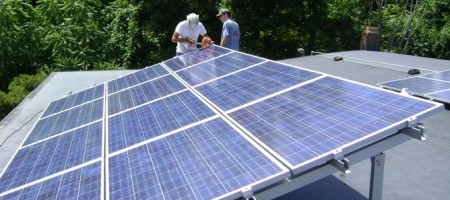Congress last month extended valuable tax credits to producers of electricity from wind turbines and solar photovoltaic panels, a move that came as a relief to an industry that has experienced rapid growth in recent years.
A tax credit for wind power producers had lapsed almost a year ago, and the credit for solar power was scheduled to decline sharply at the end of 2016. Now, renewable electricity generators have several years of unprecedented stability: the renewed wind and solar power credits don’t expire until 2020 and 2022, respectively.
The extensions were finalized just days after 196 countries agreed to reduce their greenhouse gas (GHG) emissions as part of a global effort to mitigate climate change. The White House hailed the extensions as an important step toward this goal.
Recent studies, however, indicate that tax credits are not the most effective means of achieving cutting greenhouse gas emissions. A closer look at this tax credit policy not only shows its flaws but also sheds light on how to best promote the spread of renewable energy and lower carbon emissions.
Good news for solar and wind
Tax credits have played an important role in promoting the construction of new wind and solar power capacity in U.S. Owners of solar generators receive a 30 percent tax credit on the cost of a system, while wind power generators have received as much as US$23 for every megawatt-hour of energy produced.
A 2014 study by the National Renewable Energy Laboratory found that maintaining the credit for wind power through 2020 would lead to 10 gigawatts per year of additional capacity constructed. That’s roughly the same generating capacity as 10 full-size nuclear power plants, although wind turbines produce power only about a third of the time.
In the past, the tax credit for wind had been allowed to expire for short periods before renewal and new construction fell sharply during each of these periods.
Similarly, if the solar tax credit had expired, solar power installations were expected to experience much slower growth in the years ahead. The Energy Information Agency projected residential solar power’s annual growth of 30 percent from 2013 to 2016 to slow to only six percent.
If solar power is to displace a significant share of fossil fuels for power generation, then it needs to have much higher growth. In 2014, solar power accounted for less than half of one percent of all electricity generation in the U.S., even after several years of rapid expansion.
Is there another way?
The tax credits for wind and solar power are different from many U.S. renewable energy subsidies in that their value is not determined by the amount of GHG emissions displaced by new installations.
The U.S. Renewable Fuel Standard and California’s Low Carbon Fuel Standard both provide financial incentives to produce renewable transportation fuels. Only those renewable fuels that achieve substantially lower greenhouse gas emissions than the fuels that they are displacing qualify, however.
Proponents of the solar and wind credits note that both are “zero emission” in that they generate electricity without emitting climate-changing gases. The amount of GHG emissions displaced, however, depends on which fossil fuels are displaced. This, in turn, varies widely by state.
Wyoming’s coal mines, for example, produced 39 percent of the coal mined in the country in 2013 and 88 percent of the electricity generated in the state in 2014 came from coal. Coal is one of the largest fossil sources of GHG emissions. Wyoming’s electric sector is thus one of the country’s most polluting in terms of its emissions of carbon dioxide and other GHGs.
At the opposite end of the spectrum is New York. That state derives 48 percent of its electricity from zero emission sources, notably hydropower and nuclear energy, and another 48 percent from relatively low-emission natural gas. A gigawatt of wind capacity installed in Wyoming therefore displaces more GHG emissions than in New York.
The contrast between Wyoming and New York shows how the renewed tax credits for wind and solar power are not as effective at reducing GHG emissions as they could be. This is because the credits subsidize both enegy sources equally regardless of whether the installations are displacing highly polluting fossil fuels or zero-emission renewables.
Displacing coal or hydro?
Further reducing tax credits’ effectiveness is the fact that fossil fuels remain cheaper sources of electricity than many renewables. This is true even when renewable energy receives subsidies.
Wind and solar power are most competitive in those markets with the highest electricity prices. That’s why New York has almost 1,400 times more installed solar power than Wyoming, because its electricity prices are the higher of the two.
The tax credits reinforce this disconnect between environmental benefits and installation locations by ignoring displaced GHG emissions. Yet where renewable energy is installed in the U.S. has profound implications.
A 2013 analysis published in the Proceedings of the National Academy of Sciences looked at the benefits of U.S. wind and solar power installations in multiple locations. It identified a range in the combined environmental and health benefits of $10 to $100 per megawatt-hour depending on where they were installed. The authors concluded that one megawatt-hour of wind energy produced in coal-rich Ohio yields five times the combined benefits of the same energy produced in New Mexico.
A study published this month in Nature Climate Change reached a similar conclusion. It valued the combined benefit range of U.S. renewable energy and energy efficiency projects at $14 to $170 per megawatt-hour depending on location.
Without a doubt, the extensions of the tax credits for wind and solar power will cause renewables’ share of the U.S. electricity market to displace that of fossil fuels at a much faster rate than would have otherwise been the case.
However, a growing body of research suggests that the ability of the tax credits to slow climate change would have been still greater had the value of the subsidies been instead linked to the amount of GHG emissions displaced by installing renewable energy.
Reference:
This article has been published here via Creative Commons Attribution NoDerivatives by the PVbuzz team from the original article written by Tristan R. Brown, Assistant Professor of Energy Resource Economics, State University of New York College of Environmental Science and Forestry and published on The Conversation.












Comments